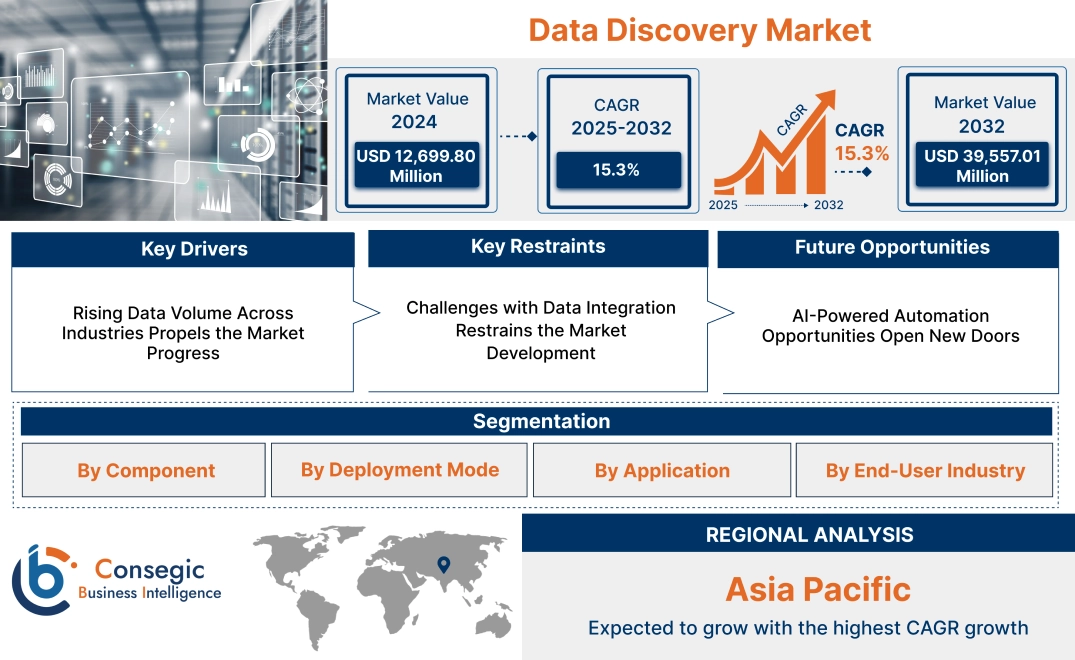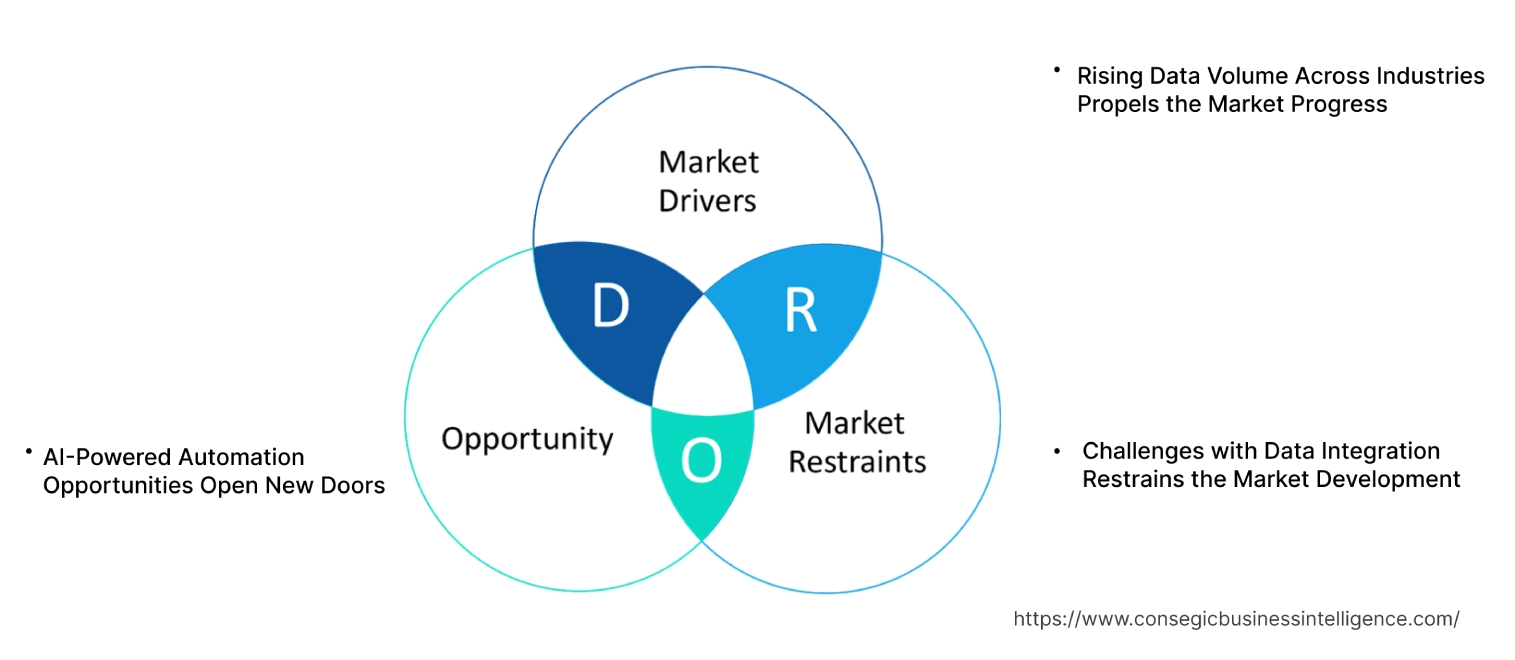- Summary
- Table Of Content
- Methodology
Data Discovery Market Size:
Data Discovery Market size is estimated to reach over USD 39,557.01 Million by 2032 from a value of USD 12,699.80 Million in 2024 and is projected to grow by USD 14,411.50 Million in 2025, growing at a CAGR of 15.3% from 2025 to 2032.
Data Discovery Market Scope & Overview:
Data discovery refers to the process of identifying, analyzing, and visualizing data to uncover patterns, trends, and insights that support decision-making. It involves the use of advanced tools and techniques to explore structured and unstructured data from various sources, enabling users to derive meaningful information efficiently. This process is widely employed in industries such as healthcare, finance, retail, and manufacturing to enhance analytics and business intelligence capabilities.
Data discovery tools offer features like data visualization, metadata management, and automated reporting, ensuring accurate and user-friendly insights. These tools integrate seamlessly with existing databases and analytics platforms, allowing organizations to access and process data from multiple sources in real time. They are designed to be intuitive, enabling both technical and non-technical users to interact with data effectively.
End-users include enterprises, government agencies, and research institutions seeking to improve data-driven decision-making and operational efficiency. These solutions play a critical role in modernizing data management processes and enhancing business intelligence.
Key Drivers:
Rising Data Volume Across Industries Propels the Market Progress
The rapid expansion of digitalization across industries like healthcare, e-commerce, banking, and manufacturing has resulted in an exponential increase in data generation. From electronic health records and financial transactions to online consumer behavior and IoT sensor data, businesses are accumulating vast amounts of structured and unstructured information. This data holds critical insights, but its sheer volume makes manual analysis impractical. As a result, organizations are turning to advanced data discovery tools to effectively filter, categorize, and analyze these datasets. These tools not only enable businesses to identify trends and anomalies but also support strategic decision-making.
With the rise of big data initiatives and real-time analytics, the demand for discovery solutions is accelerating, ensuring that businesses derive actionable insights to maintain a competitive edge in data-driven environments. This trend aligns with the growing reliance on business intelligence and analytics across sectors, driving the data discovery market growth.
Key Restraints:
Challenges with Data Integration Restrains the Market Development
Integrating data discovery tools with heterogeneous data sources poses significant constraints for organizations. Businesses often rely on diverse systems, such as legacy databases, cloud storage platforms, and on-premise infrastructures, creating fragmented and siloed data environments. These fragmented systems lack standardization, making it difficult to establish seamless connectivity and compatibility with discovery tools.
Additionally, integrating tools with older or proprietary systems requires custom solutions or additional resources, increasing complexity and costs. The technical restraints associated with mapping, transforming, and unifying data from various sources hinder the efficient deployment of discovery solutions, especially in organizations with complex IT infrastructures. This limits the ability to extract actionable insights, affecting overall operational efficiency and decision-making. As organizations increasingly adopt hybrid IT environments, the integration hurdle remains a significant barrier hindering the data discovery market demand.
Future Opportunities :
AI-Powered Automation Opportunities Open New Doors
AI-driven automation is revolutionizing data discovery by streamlining workflows and reducing the need for manual data processing. Automated features, such as real-time classification, anomaly detection, and pattern recognition, enhance the efficiency and accuracy of data insights. Industries with complex datasets, such as healthcare and manufacturing, are particularly benefiting from these advancements. For example, AI-powered tools quickly identify anomalies in patient records or detect inefficiencies in production processes, enabling faster decision-making.
Additionally, automation facilitates data categorization and integration from diverse sources, simplifying the management of large datasets. By enabling businesses to extract actionable insights with minimal human intervention, AI-powered automation is driving demand for advanced data discovery solutions, aligning with trends in data-driven decision-making across industries. This evolution presents significant data discovery market opportunities for providers offering AI-enhanced platforms.
Data Discovery Market Segmental Analysis :
By Component:
Based on components, the data discovery market is segmented into software and services.
The software segment accounted for the largest revenue of the total data discovery market share in 2024.
- Data preparation tools streamline the process of cleaning, organizing, and enriching data, enabling efficient analysis for decision-making.
- Data visualization tools allow businesses to derive actionable insights by representing complex datasets in easy-to-understand formats.
- The growth in adoption of advanced analytics and AI-powered visualization tools in sectors like BFSI and healthcare has driven the segment's dominance.
- The demand for software solutions is bolstered by their ability to simplify workflows and enhance organizational efficiency, fueling the data discovery market expansion.
The services segment is expected to register the fastest CAGR during the forecast period.
- Consulting services assist organizations in implementing tailored data discovery strategies aligned with business objectives.
- Integration services ensure seamless connectivity between data discovery tools and existing IT infrastructure for optimized performance.
- Support and maintenance services provide consistent updates and troubleshooting, ensuring operational efficiency and system reliability.
- As per the data discovery market analysis, the increasing reliance on expert services for managing large datasets and compliance requirements supports the segment’s growth trajectory.
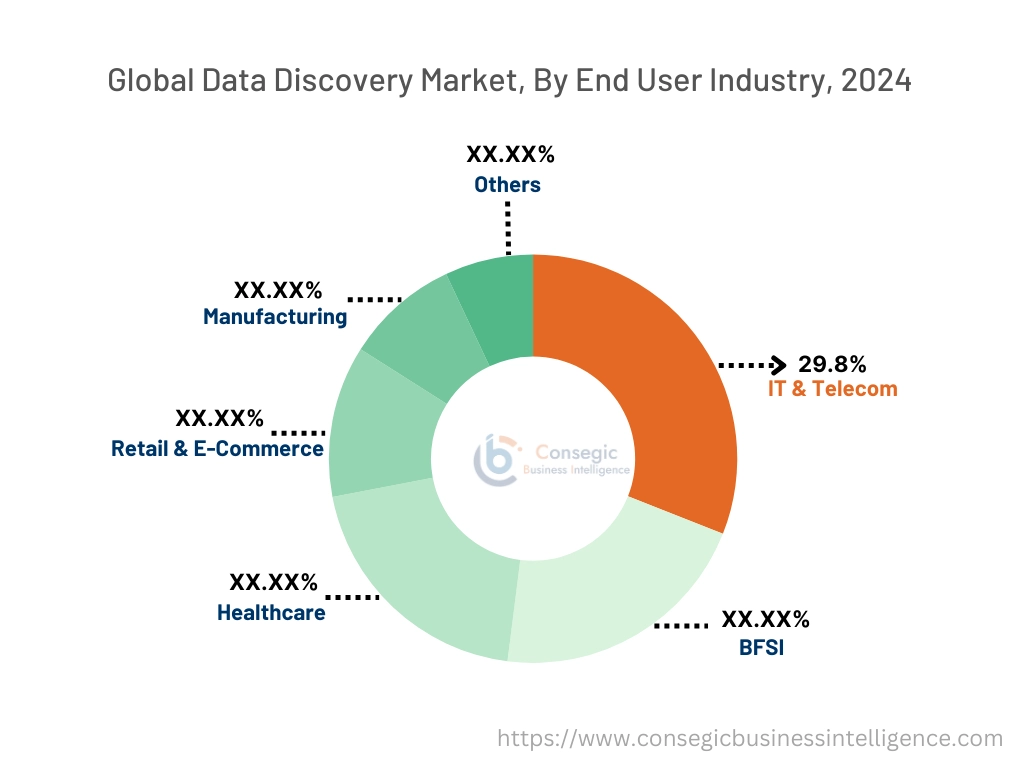
By Deployment Mode:
Based on deployment mode, the market is segmented into on-premise, cloud-based, and hybrid.
The cloud-based segment held the largest revenue of the total data discovery market share in 2024.
- Cloud-based solutions offer scalability, enabling businesses to manage increasing volumes of data without additional infrastructure costs.
- Enhanced data security protocols and compliance measures in cloud environments attract industries like BFSI and healthcare.
- The flexibility and accessibility of cloud-based platforms are driving their adoption across SMEs and large enterprises alike.
- As per the data discovery market trends, the growing shift toward digital transformation has positioned cloud-based deployments as a preferred choice for data discovery.
The hybrid segment is expected to grow at the fastest CAGR during the forecast period.
- Hybrid solutions combine the benefits of both on-premise and cloud-based deployments, offering flexibility and control over data.
- Organizations with specific regulatory or data residency requirements prefer hybrid deployments for customized solutions.
- The ability to manage sensitive data in-house while leveraging the scalability of cloud services drives the adoption of hybrid models.
- Thus, the increasing need for robust, adaptable infrastructures in industries such as IT and telecom supports the segment's rapid growth, which further boosts the data discovery market demand.
By Application:
Based on application, the market is segmented into data governance, data integration, data analytics, and data management.
The data analytics segment accounted for the largest revenue share in 2024.
- Businesses rely on data analytics to gain actionable insights, drive strategic decisions, and improve operational efficiency.
- Advanced analytics tools powered by AI and machine learning enhance predictive capabilities, further driving adoption.
- The ability to analyze customer behavior and market trends positions this segment as critical across industries such as retail and BFSI.
- Therefore, the rising importance of analytics in enhancing customer experience and competitive positioning supports the segment's dominance, driving the data discovery market growth.
The data governance segment is expected to grow at the fastest CAGR during the forecast period.
- Stringent regulatory requirements and compliance standards are driving organizations to adopt data governance frameworks.
- The integration of data governance solutions ensures the accuracy, consistency, and security of data across organizations.
- Industries such as healthcare and BFSI prioritize data governance for mitigating risks and ensuring operational transparency.
- Thus, the growing complexity of managing big data has positioned governance solutions as a key focus area for enterprises, fueling the data discovery market expansion.
By End-User Industry:
Based on the end-user industry, the market is segmented into IT & telecom, BFSI, healthcare, retail & e-commerce, manufacturing, and others.
The IT & telecom segment held the largest revenue of 29.8% share in 2024.
- IT and telecom firms generate vast amounts of data, necessitating robust data discovery tools for real-time insights.
- These tools support network optimization and predictive maintenance, enhancing service quality and reducing downtime.
- The adoption of advanced analytics in IT operations and customer experience management underscores the segment’s prominence.
- As per the data discovery market analysis, increasing investment in data-driven strategies by telecom operators has further propelled this segment’s dominance.
The healthcare segment is expected to register the fastest CAGR during the forecast period.
- Healthcare providers leverage data discovery tools for patient management, diagnostics, and predictive healthcare analytics.
- The integration of electronic health records (EHRs) and other medical data sources drives the need for advanced discovery solutions.
- Regulatory compliance and the demand for accurate, real-time insights in patient care have boosted the segment’s adoption.
- As per the data discovery market trends, the rising focus on personalized medicine and healthcare innovation supports the segment’s robust growth trajectory.
Regional Analysis:
The regions covered are North America, Europe, Asia Pacific, the Middle East and Africa, and Latin America.
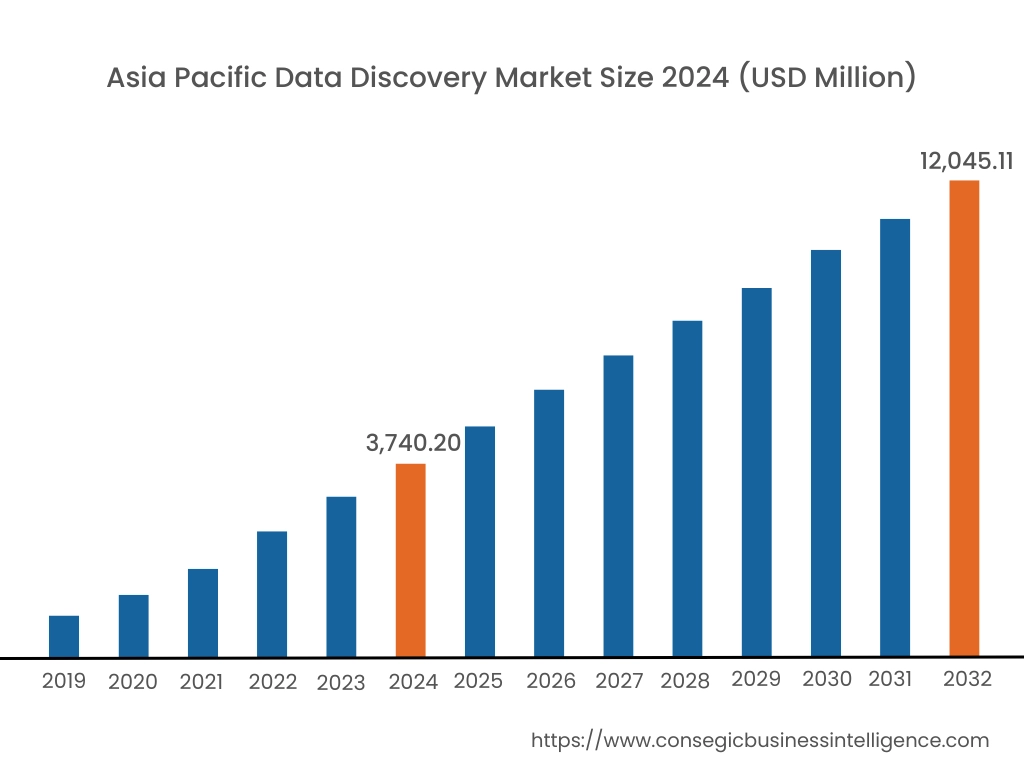
Asia Pacific region was valued at USD 3,740.20 Million in 2024. Moreover, it is projected to grow by USD 4,256.31 Million in 2025 and reach over USD 12,045.11 Million by 2032. Out of this, China accounted for the maximum revenue share of 35.2%. The Asia-Pacific region is experiencing rapid advancements in the data discovery market, driven by industrial expansion and technological progress in countries such as China, Japan, and South Korea. The proliferation of digital services and the increasing demand for scalable IT infrastructure have intensified the adoption of data discovery solutions. Government initiatives supporting digital economies further influence data discovery market opportunities.
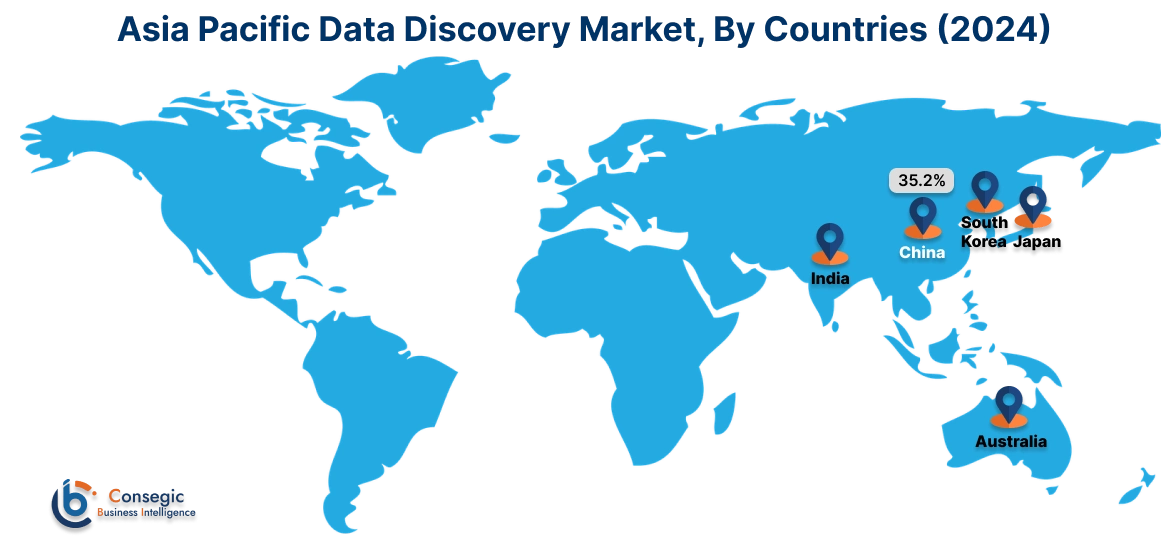
North America is estimated to reach over USD 12,820.43 Million by 2032 from a value of USD 4,212.63 Million in 2024 and is projected to grow by USD 4,771.28 Million in 2025. This region holds a substantial share of the data discovery market, driven by the early adoption of advanced analytics solutions and a robust presence of technology enterprises. The United States, in particular, has integrated data discovery tools across sectors such as finance, healthcare, and retail. A prominent trend is the incorporation of self-service data discovery platforms to enhance operational efficiency and decision-making. Analysis indicates that the presence of key industry players and continuous investment in research and development bolster the region's market leadership.
Europe represents a significant segment of the global market, with countries like Germany, France, and the United Kingdom at the forefront of adoption and innovation. The region's focus on data privacy and stringent regulatory frameworks has accelerated the deployment of data discovery solutions to ensure compliance and operational agility. Analysis reveals a growth in the trend toward utilizing data discovery in hybrid cloud environments to optimize resource utilization and reduce costs.
The Middle East & Africa region is gradually embracing data discovery technologies, particularly within the telecommunications and financial sectors. Nations like the United Arab Emirates are investing in innovative IT solutions to enhance service delivery and comply with international standards. Analysis suggests an emerging trend towards adopting data discovery to improve data management efficiency and support digital transformation initiatives.
Latin America is an emerging market for data discovery, with countries such as Brazil and Mexico contributing to its development. The region's focus on modernizing IT infrastructure and improving business agility has spurred interest in data discovery solutions. Government policies aimed at enhancing technological capabilities influence market growth.
Top Key Players and Market Share Insights:
The Data Discovery market is highly competitive with major players providing products and services to the national and international markets. Key players are adopting several strategies in research and development (R&D), product innovation, and end-user launches to hold a strong position in the global Data Discovery market. Key players in the Data Discovery industry include -
- Tableau Software (USA)
- Qlik Technologies (USA)
- SAS Institute Inc. (USA)
- MicroStrategy Incorporated (USA)
- Alteryx, Inc. (USA)
- Microsoft Corporation (USA)
- Oracle Corporation (USA)
- SAP SE (Germany)
- TIBCO Software Inc. (USA)
- IBM Corporation (USA)
Recent Industry Developments:
Product Launches:
- In December 2024, Jetico launched a new data discovery tool, Search, integrated with its BCWipe software, enabling administrators to efficiently locate and securely erase sensitive data across networks. It simplifies data spill management and ensures compliance with regulations such as PCI, GDPR, and NIS2. Key features include network-wide searches, intelligent identification of sensitive information, and deep data analysis, including in compressed files. This solution addresses the challenges of managing growing data storage and provides enhanced security for organizations.
- In November 2024, Striim launched Striim 5.0, a comprehensive platform designed to address the data management needs of generative AI applications. The release includes over 50 new features, enhanced real-time data processing, generative AI integration, and expanded connectivity. Striim 5.0 enables businesses to handle large data volumes, improve security, and accelerate time-to-value while supporting AI-driven solutions across various industries. The platform aims to streamline the deployment of modern data pipelines essential for competitive AI use cases.
- In November 2024, Cloudera announced its acquisition of Octopai, a leader in data lineage and cataloging, enhancing Cloudera's capabilities in data governance and metadata management. Octopai’s platform will enable organizations to better manage and discover trusted data across hybrid environments, boosting AI, machine learning, and analytics efforts. The integration will offer improved data discoverability, quality, and governance while ensuring compliance with data protection regulations.
- In October 2024, Metomic launched a Data Classification solution for Google Workspaces that uses AI to automate the discovery, classification, and protection of sensitive data. This tool helps IT and security teams implement data rules, ensuring compliance with regulations like ISO27001, GDPR, HIPAA, and CCPA. It automates workflows, making data management more efficient and secure, while minimizing security risks. This solution is particularly beneficial for industries like healthcare and finance.
Data Discovery Market Report Insights :
| Report Attributes | Report Details |
| Study Timeline | 2019-2032 |
| Market Size in 2032 | USD 39,557.01 Million |
| CAGR (2025-2032) | 15.3% |
| By Component |
|
| By Deployment Mode |
|
| By Application |
|
| By End-User Industry |
|
| By Region |
|
| Key Players |
|
| North America | U.S. Canada Mexico |
| Europe | U.K. Germany France Spain Italy Russia Benelux Rest of Europe |
| APAC | China South Korea Japan India Australia ASEAN Rest of Asia-Pacific |
| Middle East and Africa | GCC Turkey South Africa Rest of MEA |
| LATAM | Brazil Argentina Chile Rest of LATAM |
| Report Coverage |
|
Key Questions Answered in the Report
What is the size of the Data Discovery Market? +
The Data Discovery Market size is estimated to reach over USD 39,557.01 Million by 2032 from a value of USD 12,699.80 Million in 2024 and is projected to grow by USD 14,411.50 Million in 2025, growing at a CAGR of 15.3% from 2025 to 2032.
What are the key segments in the Data Discovery Market? +
The Data Discovery market is segmented by component, deployment mode, application, end-user industry, and region. The market components include software (data preparation tools, data visualization tools) and services (consulting, integration, support & maintenance). Deployment modes are on-premise, cloud-based, and hybrid. Applications include data governance, data integration, data analytics, and data management. End-user industries include IT & telecom, BFSI, healthcare, retail & e-commerce, manufacturing, and others. The regional segments are Asia-Pacific, Europe, North America, Latin America, and the Middle East & Africa.
Which segment is expected to grow the fastest in the Data Discovery Market? +
The data governance segment is expected to grow at the fastest CAGR during the forecast period. This growth is driven by the increasing complexity of managing big data and the growing regulatory requirements in sectors such as healthcare and BFSI, which emphasize the importance of data quality, security, and compliance.
Who are the major players in the Data Discovery Market? +
Key players in the Data Discovery market include Tableau Software (USA), Qlik Technologies (USA), Microsoft Corporation (USA), Oracle Corporation (USA), SAP SE (Germany), TIBCO Software Inc. (USA), IBM Corporation (USA), SAS Institute Inc. (USA), MicroStrategy Incorporated (USA), and Alteryx, Inc. (USA).
